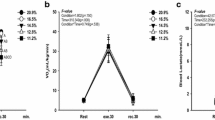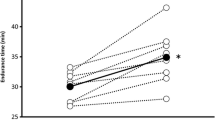Abstract
Intermittent hypoxia (IH) has been shown to alter the ventilatory and cardiovascular responses to submaximal exercise; however, the effect of IH on the cerebral blood flow (CBF) response to submaximal exercise has not been determined. This study tested the hypothesis that IH would blunt the CBF response during eucapnic and hypercapnic exercise. Nine healthy males underwent 10 consecutive days of isocapnic IH (oxyhaemoglobin saturation = 80%, 1 h day−1). Ventilatory, cardiovascular, and cerebrovascular responses to cycle exercise (50, 100, and 150 W) were measured before and after IH. Carbon dioxide (5% CO2), a mediator of CBF during exercise, was administered for 2 min of each exercise stage. Over the 10 days of IH, there was an increase in minute ventilation \( \left( {\dot{V}_{\text{E}} } \right) \) during the IH exposures (P < 0.05). Although exercise produced increases in \( \dot{V}_{\text{E}} , \) middle cerebral artery mean velocity (MCA V mean), and mean arterial pressure (P < 0.05), there was no effect of IH. Similarly, hypercapnic exercise increased \( \dot{V}_{\text{E}} \) and MCA V mean (P < 0.05); however, the magnitude of the response was unchanged following IH. Our findings indicate that ten daily hypoxia exposures does not alter the CBF response to submaximal exercise.



Similar content being viewed by others
References
Briebach T, Laubenberger J, Fischer PA (1989) The effect of physical stress on the blood flow velocity in the middle cerebral artery. A transcranial Doppler sonographic study. Ultraschall Med 10:250–253
Diomedi M, Placidi F, Cupini LM, Bernardi G, Silvestrini M (1998) Cerebral hemodynamic changes in sleep apnea syndrome and effect of continuous positive airway pressure treatment. Neurology 51:1051–1056
Endo T, Imaizumi T, Tagawa T, Shiramoto M, Ando S, Takeshita A (1994) Role of nitric oxide in exercise-induced vasodilation of the forearm. Circulation 90:2886–2890
Foster GE, McKenzie DC, Milsom WK, Sheel AW (2005) Effects of two protocols of intermittent hypoxia on human ventilatory, cardiovascular and cerebral responses to hypoxia. J Physiol 567:689–699. doi:10.1113/jphysiol.2005.091462
Foster GE, McKenzie DC, Sheel AW (2006) Effects of enhanced human chemosensitivity on ventilatory responses to exercise. Exp Physiol 91:221–228. doi:10.1113/expphysiol.2005.032276
Foster GE, Hanly PJ, Ostrowski M, Poulin MJ (2007) Effects of continuous positive airway pressure on cerebral vascular response to hypoxia in patients with obstructive sleep apnea. Am J Respir Crit Care Med 175:720–725. doi:10.1164/rccm.200609-1271OC
Garcia N, Hopkins SR, Powell FL (2000) Effects of intermittent hypoxia on the isocapnic hypoxic ventilatory response and erythropoiesis in humans. Respir Physiol 123:39–49. doi:10.1016/S0034-5687(00)00145-6
Giller CA, Giller AM, Cooper CR, Hatab MR (2000) Evaluation of the cerebral hemodynamic response to rhythmic handgrip. J Appl Physiol 88:2205–2213. doi:10.1063/1.1288503
Gilligan DM, Panza JA, Kilcoyne CM, Waclawiw MA, Casino PR, Quyyumi AA (1994) Contribution of endothelium-derived nitric oxide to exercise-induced vasodilation. Circulation 90:2853–2858
Gore CJ, Hahn AG, Aughey RJ, Martin DT, Ashenden MJ, Clark SA, Garnham AP, Roberts AD, Slater GJ, McKenna MJ (2001) Live high:train low increases muscle buffer capacity and submaximal cycling efficiency. Acta Physiol Scand 173:275–286. doi:10.1046/j.1365-201X.2001.00906.x
Heistad DD, Kontos HA (1983) Cerebral circulation. In: Shepherd JT, Abboud FM, Geiger SR (eds) Handbook of physiology: the cardiovascular system, vol III. American Physiological Society, Bethesda, pp 137–182
Huang SY, Tawney KW, Bender PR, Groves BM, McCullough RE, McCullough RG, Micco AJ, Manco-Johnson M, Cymerman A, Greene ER, Reeves JT (1991) Internal carotid flow velocity with exercise before and after acclimatization to 4, 300 m. J Appl Physiol 71:1469–1476
Iadecola C (1992) Does nitric oxide mediate the increases in cerebral blood flow elicited by hypercapnia? Proc Natl Acad Sci USA 89:3913–3916. doi:10.1073/pnas.89.9.3913
Ide K, Horn A, Secher NH (1999) Cerebral metabolic response to submaximal exercise. J Appl Physiol 87:1604–1608
Jensen JB, Sperling B, Severinghaus JW, Lassen NA (1996) Augmented hypoxic cerebral vasodilation in men during 5 days at 3, 810 m altitude. J Appl Physiol 80:1214–1218. doi:10.1063/1.362859
Jorgensen LG, Perko G, Secher NH (1992) Regional cerebral artery mean flow velocity and blood flow during dynamic exercise in humans. J Appl Physiol 73:1825–1830
Kaleth AS, Chittenden TW, Hawkins BJ, Hargens TA, Guill SG, Zedalis D, Gregg JM, Herbert WG (2007) Unique cardiopulmonary exercise test responses in overweight middle-aged adults with obstructive sleep apnea. Sleep Med 8:160–168. doi:10.1016/j.sleep.2006.08.005
Katayama K, Sato Y, Shima N, Qiu JC, Ishida K, Mori S, Miyamura M (2002) Enhanced chemosensitivity after intermittent hypoxic exposure does not affect exercise ventilation at sea level. Eur J Appl Physiol 87:187–191. doi:10.1007/s00421-002-0594-4
Kirkham FJ, Padayachee TS, Parsons S, Seargeant LS, House FR, Gosling RG (1986) Transcranial measurement of blood velocities in the basal cerebral arteries using pulsed Doppler ultrasound: velocity as an index of flow. Ultrasound Med Biol 12:15–21. doi:10.1016/0301-5629(86)90139-0
Kolb JC, Ainslie PN, Ide K, Poulin MJ (2004) Effects of five consecutive nocturnal hypoxic exposures on the cerebrovascular responses to acute hypoxia and hypercapnia in humans. J Appl Physiol 96:1745–1754. doi:10.1152/japplphysiol.00977.2003
Krause DN, Duckles SP, Pelligrino DA (2006) Influence of sex steroid hormones on cerebrovascular function. J Appl Physiol 101:1252–1261. doi:10.1152/japplphysiol.01095.2005
Lavie L (2003) Obstructive sleep apnoea syndrome—an oxidative stress disorder. Sleep Med Rev 7:35–51. doi:10.1053/smrv.2002.0261
Levine BD, Stray-Gundersen J (1997) “Living high-training low”: effect of moderate-altitude acclimatization with low-altitude training on performance. J Appl Physiol 83:102–112
Lusina SJ, Kennedy PM, Inglis JT, McKenzie DC, Ayas NT, Sheel AW (2006) Long-term intermittent hypoxia increases sympathetic activity and chemosensitivity during acute hypoxia in humans. J Physiol 575:961–970. doi:10.1113/jphysiol.2006.114660
Marshall HC, Hamlin MJ, Hellemans J, Murrell C, Beattie N, Hellemans I, Perry T, Burns A, Ainslie PN (2008) Effects of intermittent hypoxia on SaO2, cerebral and muscle oxygenation during maximal exercise in athletes with exercise-induced hypoxemia. Eur J Appl Physiol 104:383–393. doi:10.1007/s00421-007-0616-3
Phillips SA, Olson EB, Morgan BJ, Lombard JH (2004) Chronic intermittent hypoxia impairs endothelium-dependent dilation in rat cerebral and skeletal muscle resistance arteries. Am J Physiol Heart Circ Physiol 286:H388–H393. doi:10.1152/ajpheart.00683.2003
Placidi F, Diomedi M, Cupini LM, Bernardi G, Silvestrini M (1998) Impairment of daytime cerebrovascular reactivity in patients with obstructive sleep apnoea syndrome. J Sleep Res 7:288–292. doi:10.1046/j.1365-2869.1998.00120.x
Pott F, Jensen K, Hansen H, Christensen NJ, Lassen NA, Secher NH (1996) Middle cerebral artery blood velocity and plasma catecholamines during exercise. Acta Physiol Scand 158:349–356. doi:10.1046/j.1365-201X.1996.564325000.x
Poulin MJ, Robbins PA (1996) Indexes of flow and cross-sectional area of the middle cerebral artery using Doppler ultrasound during hypoxia and hypercapnia in humans. Stroke 27:2244–2250
Poulin MJ, Syed RJ, Robbins PA (1999) Assessments of flow by transcranial Doppler ultrasound in the middle cerebral artery during exercise in humans. J Appl Physiol 86:1632–1637
Querido JS, Sheel AW (2007) Regulation of cerebral blood flow during exercise. Sports Med 37:765–782. doi:10.2165/00007256-200737090-00002
Querido JS, Godwin JB, Sheel AW (2008) Intermittent hypoxia reduces cerebrovascular sensitivity to isocapnic hypoxia in humans. Respir Physiol Neurobiol 161:1–9. doi:10.1016/j.resp.2007.11.002
Rasmussen P, Stie H, Nielsen B, Nybo L (2006) Enhanced cerebral CO2 reactivity during strenuous exercise in man. Eur J Appl Physiol 96:299–304. doi:10.1007/s00421-005-0079-3
Rowell LB, Taylor HL, Wang Y, Carlson WS (1964) Saturation of arterial blood with oxygen during maximal exercise. J Appl Physiol 19:284–286
Townsend NE, Gore CJ, Hahn AG, Aughey RJ, Clark SA, Kinsman TA, McKenna MJ, Hawley JA, Chow CM (2005) Hypoxic ventilatory response is correlated with increased submaximal exercise ventilation after live high, train low. Eur J Appl Physiol 94:207–215. doi:10.1007/s00421-004-1252-9
Valdueza JM, Balzer JO, Villringer A, Vogl TJ, Kutter R, Einhaupl KM (1997) Changes in blood flow velocity and diameter of the middle cerebral artery during hyperventilation: assessment with MR and transcranial Doppler sonography. AJNR Am J Neuroradiol 18:1929–1934
Wang JS, Chen LY, Fu LL, Chen ML, Wong MK (2007) Effects of moderate and severe intermittent hypoxia on vascular endothelial function and haemodynamic control in sedentary men. Eur J Appl Physiol 100:127–135. doi:10.1007/s00421-007-0409-8
Whipp BJ (1994) Peripheral chemoreceptor control of exercise hyperpnea in humans. Med Sci Sports Exerc 26:337–347
Zimmermann C, Haberl RL (2003) l-Arginine improves diminished cerebral CO2 reactivity in patients. Stroke 34:643–647. doi:10.1161/01.STR.0000056526.35630.47
Acknowledgements
This study was supported by the Natural Sciences and Engineering Research Council of Canada (NSERC) and the Canadian Foundation for Innovation. J. S. Querido was supported by a Junior Graduate Studentship from the Michael Smith Foundation for Health Research (MSFHR) and a Postgraduate scholarship from NSERC. A. W. Sheel was supported by a Scholar award from the MSFHR and a New Investigator award from the Canadian Institutes of Health Research.
Author information
Authors and Affiliations
Corresponding author
Rights and permissions
About this article
Cite this article
Querido, J.S., Rupert, J.L., McKenzie, D.C. et al. Effects of intermittent hypoxia on the cerebrovascular responses to submaximal exercise in humans. Eur J Appl Physiol 105, 403–409 (2009). https://doi.org/10.1007/s00421-008-0917-1
Accepted:
Published:
Issue Date:
DOI: https://doi.org/10.1007/s00421-008-0917-1




